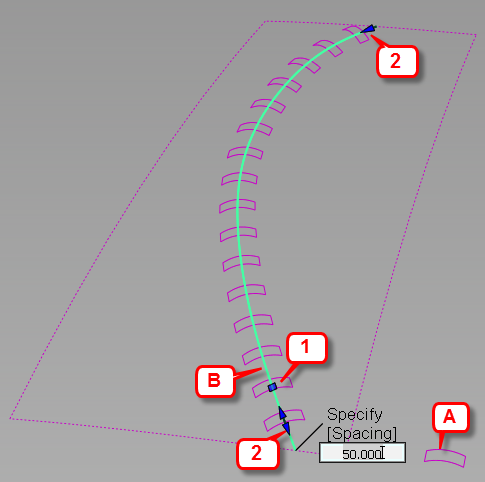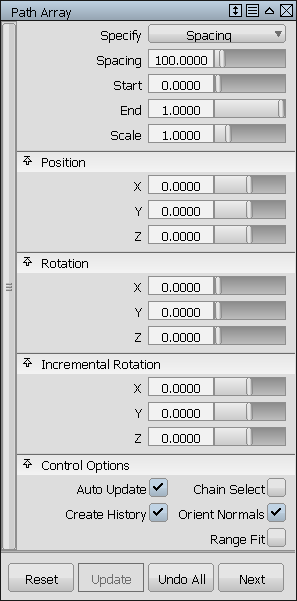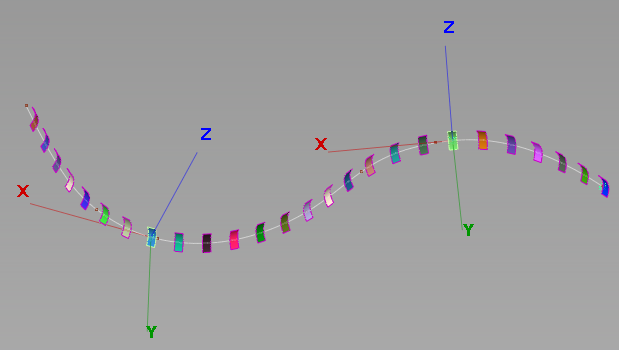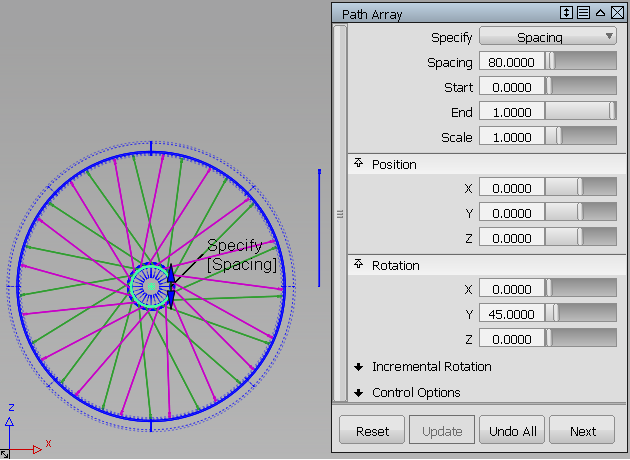Transform > Path Array  is a new tool that lets you lay down "stitch patterns". In other words, it duplicates one or more objects and places the copies at equal distances along one or more curves.
is a new tool that lets you lay down "stitch patterns". In other words, it duplicates one or more objects and places the copies at equal distances along one or more curves.

A: Stitch object. B: Target curve. 1: Spacing manipulator. 2. Range (Start/End) manipulators.
Through the option window and manipulators, you control the spacing, range, position, and orientation of the duplicates.
Create and place duplicates (stitch pattern)
- Choose Transform > Path Array

- Select the stitch objects. They can be curves, surfaces, or meshes.
- Click the Build button in the lower right corner of the view window.
- Select the target curves. They can be free curves, curves-on-surface, surface edges, trim edges, or isoparms (including precision lines).
- Duplicates of the stitch objects appear along the length of the curves. The pivot points of the duplicates are placed along the curves and used to calculate spacing.
- Range arrow manipulators appear at the start and end of the last target curve.
- A Spacing/Number manipulator also appears, with a Specify label that you can click to toggle between Spacing and Number adjustments. Clicking the numerical value below the label lets you enter an exact value. The Spacing manipulator is a small square on the second duplicate. The Number manipulator is a set of two arrowheads used to decrement/increment the value.
- Modify the spacing, range, and orientation of the duplicates through the control options. You can also use the manipulators to modify the spacing and range directly on the model.
The duplicate objects have history and update as the options are modified.
Note: Only duplicates along the last selected target curve are affected. - Select additional target curves if desired.
Options

- Specify
- Choose Spacing or Number from the pull-down menu.
This option also appears as a toggling label on the model.
- Spacing / Number
-
Depending on the value of the Specify option.
Spacing – The distance between the duplicates, in current units.
Number – The number of duplicates.
These values can also be set by using the corresponding manipulator on the model.
- Start/End
- Specifies where the duplicates start and end along the curve. Start and End values of 0.0 and 1.0 respectively define the original extent.
These values can also be set by using the range manipulators on the path curve.
- Scale
- This is a relative scale factor applied to the first duplicate to produce the last duplicate. The sizes of intermediate duplicates are linearly interpolated.
- Position
- Offset in the X, Y, and Z directions along the duplicates local axes (in current units).
- Rotation X/Y/Z
- Rotation around the local X, Y, and Z axes of the duplicates (in current units).
- Incremental Rotation X/Y/Z
- Rotation around the local X, Y, and Z axes of the duplicates by a relative angle with respect to the previous duplicate. For example, if the X value is 10.0 (degrees), each duplicate is rotated ten degrees more around X than the previous one, producing a twisting effect along the path.
Control Options
- Auto Update
- When checked, duplicates update automatically when values in the control window are changed.
- Chain Select
- When checked, selecting a curve also selects all other curves that are tangent continuous with it.
- Create History
- When checked, the duplicates have construction history. Modifying the stitch objects or target curves causes the duplicates to update accordingly.
- Range Fit
- Check this box to ensure that the duplicates fit the entire length of the curves specified by the Start and End positions. This action sometimes causes the Spacing to change (not reflected in the option window).
- Orient Normals
-
Check this box to align the local X axis of each duplicate with the tangent of the target curve at the position of the duplicate. If the target curve is a curve-on-surface, each duplicate is oriented so that its local Z axis matches the normal direction of the surface where the curve-on-surface lies. If the target curve is a free curve, the Z axis of each duplicate is oriented along the direction of the curvature vector of the curve (like plot combs).
 Note: If the curvature of the curve changes direction, the duplicates orientation does not flip at inflection points.
Note: If the curvature of the curve changes direction, the duplicates orientation does not flip at inflection points.If this box is not checked, all the duplicates have the same orientation as the original stitch object.
Example
In the following image, a spoke (two surfaces, shown to the right of the bicycle wheel) is duplicated and placed along a circular path curve (inner rim). The operation is repeated twice to create two sets of spokes: one rotated by 45 degrees around Y (in pink), and the other rotated by 315 degrees around Y (in green).
